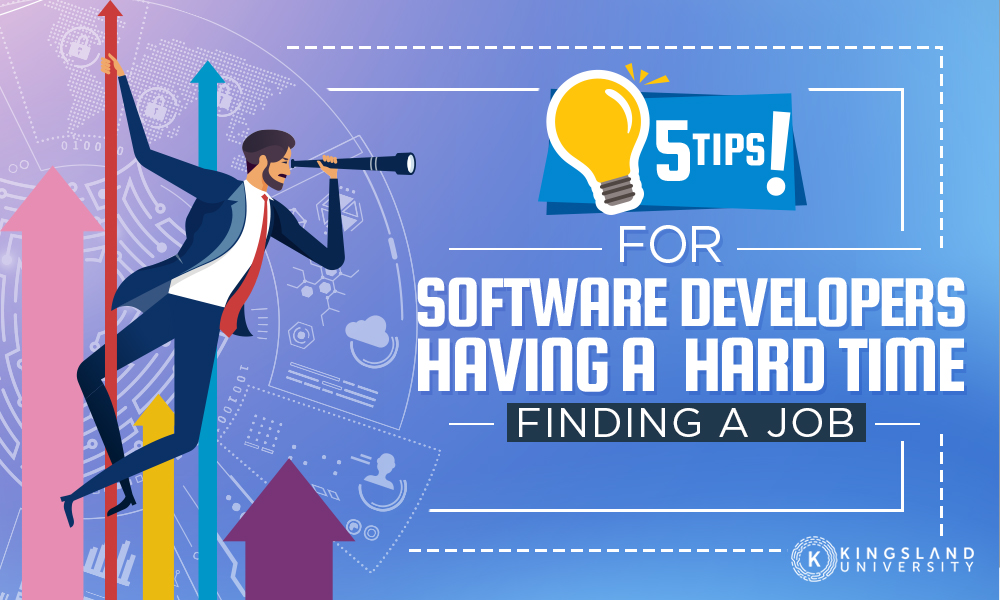
One of the most stressful challenges Americans face today is finding gainful employment, especially for those in competitive fields. Jobs have become an increasingly valuable commodity as employers strengthen hiring requirements to, in some cases, almost unreasonable degrees. This standard is even higher for aspiring developers due to the high level of knowledge and desired experience the average employer will seek from applicants. Many might think that simply having a university degree is all it takes to catch the eye of a potential employer, but this is a misconception that has been the downfall of many an application.
Fortunately, there are several methods you can employ to pad your résumé and make yourself the ideal candidate for a position at even the most demanding software development firms.
Tip #1: Portfolios
One of the best possible ways to stand out to a potential employer is to prove your skill with projects that required executing those skills. A portfolio is a term you have likely heard tossed around school or even amongst proven professionals for a wide array of careers. The field of software development is no exception to this rule. Having a portfolio of your work helps demonstrate your effective skill level and proofs-of-concept that might benefit you professionally and make you a more appealing hiring prospect.
Portfolios, while hosting an array of your work, do not follow set patterns and are generally tailored to the style of the one writing it or, in some cases, in a manner that is more appealing to their preferred employers. However, there are three components all portfolios must have to have even the slightest chance of increasing the odds of being hired.
- About Me: An about me section might seem like a trivial addition to any document you submit to a potential employer, but it is vital to a portfolio. This section gives employers an insight into who you are, not just as a worker but also as a person. This section includes your name and a small summary of your professional and educational history with a segment about where you would like to be professionally in the future.
- Projects: The lifeblood of all portfolios, the projects section is where you will host all the best samples of your work. You want to use this section to maximize the impact of what you are capable of by making this section as appealing and visually stimulating as possible. Make it creative in a way that highlights the section without detracting from the focus on your actual work.
- Contact Information: The contact information section of your portfolio will make it difficult to get responses to applications if you forgo it. As you might expect, it includes your phone number and e-mail address. However, it should also include your social media links where professionally relevant, such as Twitter or Instagram. You should also consider adding your LinkedIn and GitHub to cement the opportunities for work.

A portfolio is generally a requirement to be considered for even junior developer positions, but making it correctly can be the difference between success and failure. Your portfolio should be tailored with samples relevant to the position and firm you are applying to so you can maximize the odds of being hired. It can also be beneficial to include extracurricular activities that can highlight crucial and appealing skills you possess that might be of use to an employer and elevate you as a prospective hire over others after the same position.
Tip #2: Résumé and Cover Letter
While it might seem obvious, a well-tailored résumé is an extremely underrated necessity for many applicants. Most résumés written up by those who lack experience are equally lacking in the fine-tuning that makes it genuinely great. Many résumés written by first-time applicants tend to have an abundance of grammatical errors and are overly cluttered with irrelevant information that turns reviewing them into a slog for potential employers.
When writing your résumé, be sure to review the grammar and punctuation of every sentence you have typed out. But the most important thing to look out for when writing your résumé is making sure that the history of education is listed, with your most advanced degree at the forefront. You should also list all your professional and extracurricular experiences that relate to the field of software development. Lean on things like degrees in computer science and clubs relating to programming, coding, or anything of a similar nature.

For your cover letter, be sure to avoid copying and pasting from a generic template that, in all likelihood, is being used by countless other applicants looking for their first-time employment. Instead of using something that every other applicant is using, take some time to familiarize yourself with the company you are applying to by visiting their website and reviewing their charter. Learn what about the company genuinely wants to make you work there and why. Then, take that reason and express it in the most eloquent way possible.
If you cannot find a genuine reason for wanting to work, search for other firms that are more in line with your skills and goals to effectively integrate with them without suffering through a job you cannot stand. If you don’t genuinely want to work for a company, it will come through on your cover letter and will likely disqualify you from employment.
Tip #3: Certifications
Software development is a field that requires a fair degree of knowledge and experience to succeed that can even come in the form of non-professional or university-based education. Like almost all fields that revolve around computers, there are certifications that you can earn through a course and exam that demonstrate skills and knowledge that make you stand out as a potential employee.
- Microsoft Technology Associate Developer (MTA): This certification is geared toward high schoolers, university students, and general newcomers to the field of development that educates applicants on the use of tools that aid in the development of software, applications, and games for Microsoft Windows operating systems.
- Microsoft Certified Solutions Developer (MCSD): The MCSD certification is geared towards intermediately skilled applicants who have already demonstrated knowledge in developing applications for Windows operating software. This certification builds on knowledge gleaned from the MTA certification to advance the kinds of applications you can make for Windows and offers knowledge on making website applications as well as applications sold on Windows’ digital storefront.
- Citrix Certified Associate-Virtualization: The CCV-A certification is geared towards newcomers to the field, just like the MTA certification. Unlike the MTA, however, the CCV-A certification is for XenDesktop applications. It allows graduates of the class to learn how to configure, manage, monitor, and maintain applications for the XenDesktop software and even serves as a stepping stone to the more demanding and advanced Citrix Certified Professional-Virtualization (CCP-V) certification.
- AWS Certified Developer-Associate (AWS CD-A): The AWS CD-A certification, aside from being a mouthful, educates developers on designing and maintaining applications for the Amazon Web Services digital platform. It shows experience using Amazon toolkits to create and enhance cloud-based applications and databases, which are becoming more and more popular with businesses across the world.
- Google Certified Professional Cloud Architect (GCPCA): Another certification based on using tools from a giant in the computer industry, the GCPCA certification serves as a badge of using Google’s toolkits for cloud-based applications development and maintenance. While considered an entry-level certification, it provides opportunities for professional-level certifications and, like the others, helps you stand out as an applicant.

Certifications are extremely valuable resources for anyone struggling to find employment by adding to your skillset in a relatively short time frame. When listed on a résumé, certifications demonstrate to your potential employers that you actively seek out knowledge that will help you do your job effectively. It also demonstrates that you are willing to learn more even after being employed to become a more effective employee who can take on more demanding tasks and projects. While certifications are not surefire tools for getting employed, they serve as a fantastic way to bolster your qualifications to tilt the odds in your favor.
Tip #4: Internships
It is an age-old story. You are fresh out of university, dedicating all your time to getting the grade in your degree plan for computer science to become a developer. But when you finally start applying for jobs, they might all want three to five years of experience to even be considered for full-time entry-level employment. You might be wondering how you are supposed to get that experience when you need the experience to get it. It is a confusing, vicious cycle that has an amazingly simple answer. Internships. Internships are generally unpaid temporary employment opportunities offered to university students to help them get experience in the field before setting out for full-time employment.
Some exclusive internships offer paid opportunities but have even more stringent requirements for consideration than the unpaid variety. Like full-time employment, your résumé and cover letter are vital aspects of your application to an internship. You also need to maintain a high GPA to edge out your competition and prove yourself as the best choice for the opportunity.

While getting an internship can be challenging and exhausting, the benefits they provide are incredibly valuable to you professionally. Internships help you get the experience you need to make it past the experience requirements entry-level developer positions demand. In addition, the internships demonstrate that you are familiar with the workplace environment you are aiming to get into and make it an easier transition into full-time employment. In some cases, your internship can even evolve into a full-time position if you impress the company well enough to make them want you as a permanent member of the team.
Tip #5: Boot Camps and Networking
Keeping in line with the advancement of your skillset and knowledge insofar as software development is concerned, there exist programming boot camps that you can attend online. These boot camps are crash courses you can sign up for online to understand the fundamentals of basic programming and coding tools and even new kits that come out after you have established yourself professionally.
Boot camps demonstrate a willingness and drive to learn about toolkits and techniques that will invariably come into play during your full-time work. As you might expect, having certificates from the boot camps look particularly good on résumés alongside your university degree and can help you make a lasting impression on your potential employer.

The boot camps offer other opportunities, though not as frequently, to encounter professionals in the field already. Probably the most important tool for employment, networking can work wonders on your employment odds. If you attend a party or are even just walking through your local grocery store and you bump into someone involved in the field, you suddenly have a connection to the field. If you happen to attend a boot camp where the teacher is an established professional or one of your fellow “campers” is a professional getting a refresher or crash course on toolkits gives you an opportunity to talk shop.
Making a lasting impression on strangers with inroads into the software development industry means they might think of you when it comes time to hire new developers and engineers for their firm.
The Final Byte
Getting employed these days can be extremely difficult as the requirements for being employed become more stringent to ensure only the best possible employees get the position. With all these new requirements, it falls to you to stand out and make a lasting impression on whoever is conducting your interview and determining your future at the company.
So, when seeking employment, make sure your résumé is up to snuff with only the relevant details and proper grammar included with a cover letter that stands out from the generic templates littering the internet. Ensure your portfolio highlights your best work to date that relates to the work you will be doing for the company. Go out and get the certifications and boot camp education that will help you show a drive to understand the field all the better while meeting new potential contacts who already exist within the field.

Employment is not something that comes easily, and it will not be handed to you on a platter, especially in a field as competitive as software design. However, with the right qualifications, you can astound and impress even the most obtuse employers.


